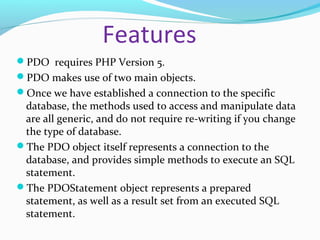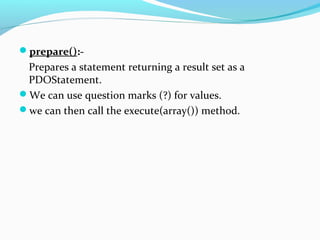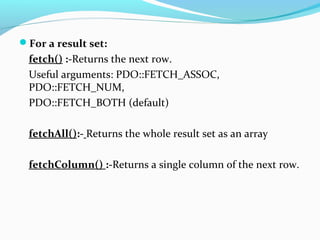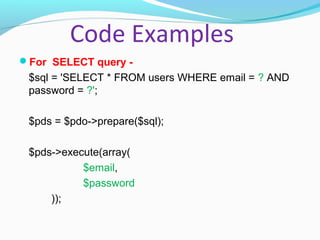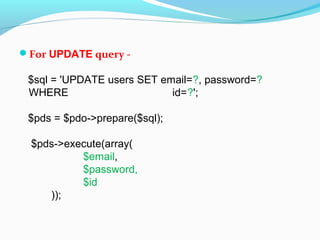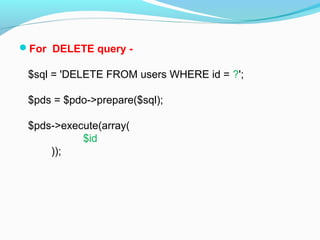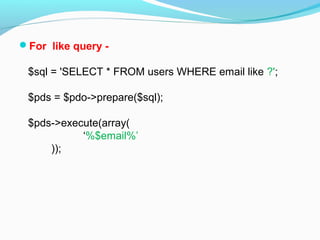PHP - PDO Objects
- 1. Presented by:- Mr. Ajinkya NaharMr. Ajinkya Nahar Twitter - @ajinkyanaharTwitter - @ajinkyanahar LinkedIn âLinkedIn â http://in.linkedin.com/pub/ajinkya-http://in.linkedin.com/pub/ajinkya- nahar/8/404/77bnahar/8/404/77b
- 2. Features ïPDO requires PHP Version 5. ïPDO makes use of two main objects. ïOnce we have established a connection to the specific database, the methods used to access and manipulate data are all generic, and do not require re-writing if you change the type of database. ïThe PDO object itself represents a connection to the database, and provides simple methods to execute an SQL statement. ïThe PDOStatement object represents a prepared statement, as well as a result set from an executed SQL statement.
- 3. PDO Object and most useful statement ïThis represents a connection to the Database. ïAll database operations are initiated through the PDO object. The PDO object is created when you connect to the database. ïAfter that, we can use its methods to access the database. ïexec():- Execute an SQL statement returning the number of rows affected. ïquery() :- Execute an SQL statement returning a result set as a PDOStatement .
- 4. ïprepare():- Prepares a statement returning a result set as a PDOStatement. ïWe can use question marks (?) for values. ïwe can then call the execute(array()) method.
- 5. ïThe PDOStatement represents a prepared statement, as well as a returned result set. ïPDO->query operation (where it represents a result set), a ïPDO->prepare operation (where it represents a prepared statement) or a ïPDO->execute operation (where it represents a result set from your prepared statement) ïFor a prepared statement:- execute() :-Execute the prepared statement. We can use an array of values to replace the question mark parameters. Prepared Statement
- 6. ïFor a result set: fetch() :-Returns the next row. Useful arguments: PDO::FETCH_ASSOC, PDO::FETCH_NUM, PDO::FETCH_BOTH (default) fetchAll():- Returns the whole result set as an array fetchColumn() :-Returns a single column of the next row.
- 7. $database = âdatabase_name'; $user = âuser'; $password = âpassword'; $dsn = "mysql:host=localhost;dbname=$database"; try { $pdo = new PDO ($dsn, $user, $password); } catch(PDOException $e) { die ('Oops'); // Exit, displaying an error message } Establish Connection to MySql
- 8. Code Examples ïFor SELECT query - $sql = 'SELECT * FROM users WHERE email = ? AND password = ?'; $pds = $pdo->prepare($sql); $pds->execute(array( $email, $password ));
- 9. ïFor INSERT query - $sql = 'INSERT INTO users(email,password) VALUES(?,?)'; $pds = $pdo->prepare($sql); $pds->execute(array( $email, $password ));
- 10. ïFor UPDATE query - $sql = 'UPDATE users SET email=?, password=? WHERE id=?'; $pds = $pdo->prepare($sql); $pds->execute(array( $email, $password, $id ));
- 11. ïFor DELETE query - $sql = 'DELETE FROM users WHERE id = ?'; $pds = $pdo->prepare($sql); $pds->execute(array( $id ));
- 12. ïFor like query - $sql = 'SELECT * FROM users WHERE email like ?'; $pds = $pdo->prepare($sql); $pds->execute(array( â%$email%â ));


